Dynamic Leadership: Self-Assessment of Leadership Journey and Plan
VerifiedAdded on 2023/04/21
|11
|2755
|184
Report
AI Summary
This report provides a comprehensive self-assessment of a student's leadership journey, examining their strengths, weaknesses, and areas for future development. The student, a nurse leader, identifies their leadership style as transformational and reflects on their experiences in setting priorities, delegating tasks, making decisions, solving problems, communicating, and resolving conflicts. The report highlights the student's proficiency in delegation and decision-making but acknowledges weaknesses in conflict resolution and communication. A plan of action is outlined, including strategies to improve these areas. The report concludes with an emphasis on the importance of self-leadership and continuous development for effective leadership. It references various academic sources to support its claims and analysis, offering insights into leadership theories and practices. Students can find this and other similar reports, as well as past papers and solved assignments, on Desklib to aid their learning and understanding of leadership principles.
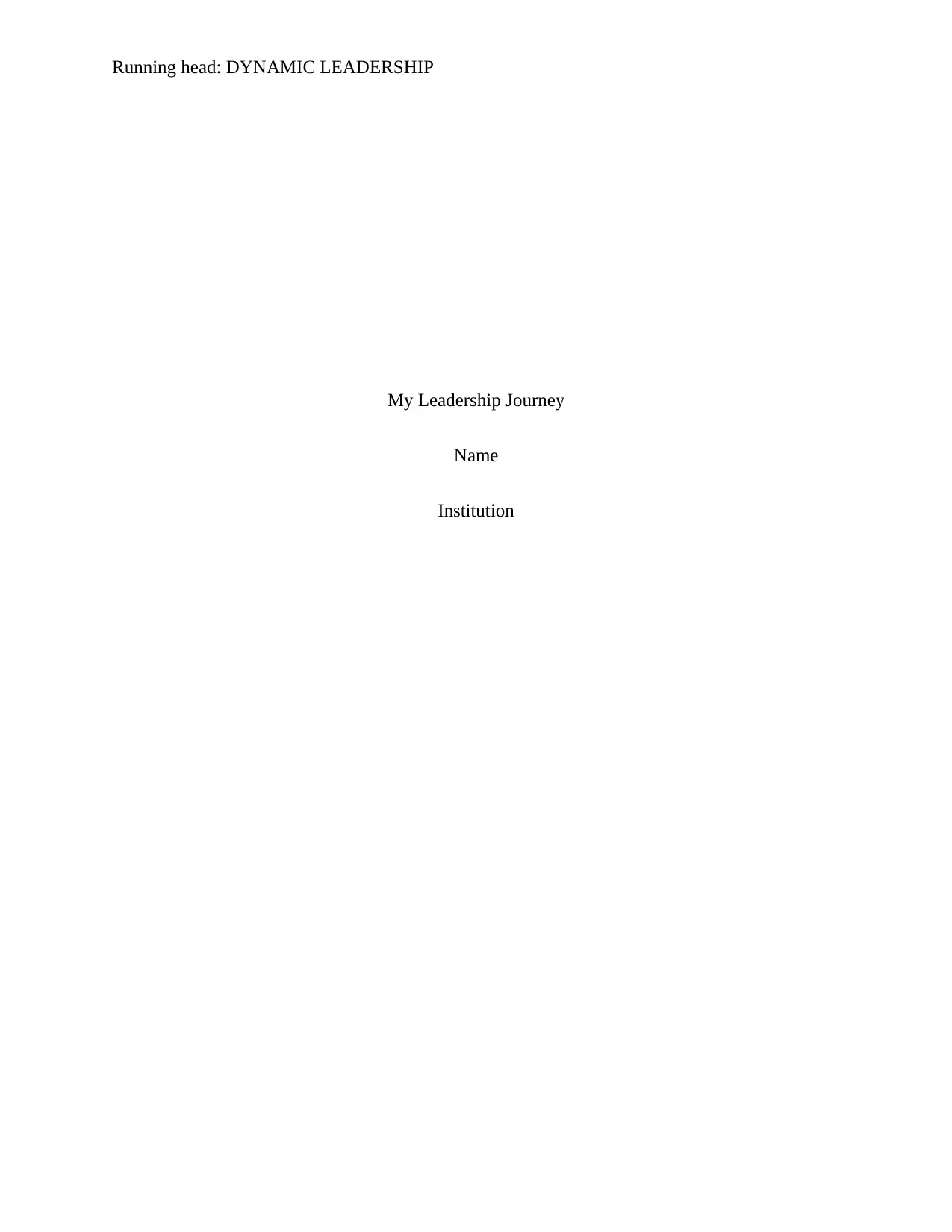
Running head: DYNAMIC LEADERSHIP
My Leadership Journey
Name
Institution
My Leadership Journey
Name
Institution
Paraphrase This Document
Need a fresh take? Get an instant paraphrase of this document with our AI Paraphraser

DYNAMIC LEADERSHIP 2
Introduction
Mayfield and Mayfield (2016) assert that leadership is not only found in workplaces but
all around us. In any circumstance, leaders make a step ahead and take control of the situation. It
may be at home, at the workplace, or any other place. Leaders are never born, they turn out to be
leaders since they possess the trustworthiness and individuals would love to follow them
(Drescher, 2017). Leaders are individuals amongst us who are unique by their work and thinking
integrity. Such people are ever willing to learn and making different leaders by sharing
experience and knowledge with others. This paper discusses my leadership strengths and areas
for future study or growth. It also includes how these qualities are utilized in my everyday work
routine, self-assessment results, and a brief explanation of the individual style of leadership.
My Leadership Background and Theory
I am a nurse leader for the interns at the healthcare organization where I work. I was
appointed to this position after my seniors proposed to the hospital administration that I had
outstanding qualities that were fit for the position that I am currently assigned. I have been a
nurse leader for three months now and I must say that the leadership experience is challenging,
yet self-fulfilling. I have confidence that I am a good leader since I believe that every effective
leader recognizes that their power to attain organizational goals originates from having a driven
team who partakes in the organization’s vision. Besides my ability to create distinct visions and
identify means to accomplish goals, I am a people-oriented person who believes that individuals
execute at their best when the roles they play allows them to attain their maximum potentials as
human beings and employees as well. This implies that I do not take an authoritative outlook to
leadership, instead, I consider enabling all employees. For these explanations, my leadership
Introduction
Mayfield and Mayfield (2016) assert that leadership is not only found in workplaces but
all around us. In any circumstance, leaders make a step ahead and take control of the situation. It
may be at home, at the workplace, or any other place. Leaders are never born, they turn out to be
leaders since they possess the trustworthiness and individuals would love to follow them
(Drescher, 2017). Leaders are individuals amongst us who are unique by their work and thinking
integrity. Such people are ever willing to learn and making different leaders by sharing
experience and knowledge with others. This paper discusses my leadership strengths and areas
for future study or growth. It also includes how these qualities are utilized in my everyday work
routine, self-assessment results, and a brief explanation of the individual style of leadership.
My Leadership Background and Theory
I am a nurse leader for the interns at the healthcare organization where I work. I was
appointed to this position after my seniors proposed to the hospital administration that I had
outstanding qualities that were fit for the position that I am currently assigned. I have been a
nurse leader for three months now and I must say that the leadership experience is challenging,
yet self-fulfilling. I have confidence that I am a good leader since I believe that every effective
leader recognizes that their power to attain organizational goals originates from having a driven
team who partakes in the organization’s vision. Besides my ability to create distinct visions and
identify means to accomplish goals, I am a people-oriented person who believes that individuals
execute at their best when the roles they play allows them to attain their maximum potentials as
human beings and employees as well. This implies that I do not take an authoritative outlook to
leadership, instead, I consider enabling all employees. For these explanations, my leadership

DYNAMIC LEADERSHIP 3
style is best revealed in the transformational leadership style. According to the Nurse Education
in Practice (2018), a transformation leader is one who inspires members to execute to their
maximum potential over direction. Such leaders use personality, personalized reflection, and
logical stimulation to yield pronounced effort, efficiency, and fulfillment in members. Healthcare
organization have to continuously assess nurse leaders to uphold transformational qualities of
leadership since constructive transformational amendments in nursing generate a useful trickle-
down-effect in the delivery of health care (Skendzel, Holtan, and Finch-Guthrie, 2019). Such
leadership is important in nursing as it stimulates the development of a culture of superiority and
that organizations with such leaders have features such as superiority and contentment in the job,
passion, team spirit, a sense of achievement and fulfillment (Nurse Education Today, 2017).
Priority Setting
Setting priorities is an essential aspect of everyday life, whether at home, work or play
(Germain, 2017). As a leader, I am certain that I am skilled in setting priorities since I set
priorities founded on whether the choices I make would accomplish the projected goals. For
instance, in the course of my university years, I decided that it was important for me to work
while attending school. Whereas the bigger picture is to get a degree so that I may attain upward
flexibility, my top most priority is to be effective on the job and accomplish my job
responsibilities. This implies that if my college timetable should clash with my job duties, I
would rather make the required alterations to my college timetable. This is because college is a
long-standing goal while my current job enables that long-standing goal by generating income
besides experience that would advance my upcoming undertakings. Therefore, one method that I
set priorities is founded on the relevance of tasks, duties, or activities. I similarly set priorities
founded on the time-sensitiveness of the duty. Since I set priorities founded on the convenience
style is best revealed in the transformational leadership style. According to the Nurse Education
in Practice (2018), a transformation leader is one who inspires members to execute to their
maximum potential over direction. Such leaders use personality, personalized reflection, and
logical stimulation to yield pronounced effort, efficiency, and fulfillment in members. Healthcare
organization have to continuously assess nurse leaders to uphold transformational qualities of
leadership since constructive transformational amendments in nursing generate a useful trickle-
down-effect in the delivery of health care (Skendzel, Holtan, and Finch-Guthrie, 2019). Such
leadership is important in nursing as it stimulates the development of a culture of superiority and
that organizations with such leaders have features such as superiority and contentment in the job,
passion, team spirit, a sense of achievement and fulfillment (Nurse Education Today, 2017).
Priority Setting
Setting priorities is an essential aspect of everyday life, whether at home, work or play
(Germain, 2017). As a leader, I am certain that I am skilled in setting priorities since I set
priorities founded on whether the choices I make would accomplish the projected goals. For
instance, in the course of my university years, I decided that it was important for me to work
while attending school. Whereas the bigger picture is to get a degree so that I may attain upward
flexibility, my top most priority is to be effective on the job and accomplish my job
responsibilities. This implies that if my college timetable should clash with my job duties, I
would rather make the required alterations to my college timetable. This is because college is a
long-standing goal while my current job enables that long-standing goal by generating income
besides experience that would advance my upcoming undertakings. Therefore, one method that I
set priorities is founded on the relevance of tasks, duties, or activities. I similarly set priorities
founded on the time-sensitiveness of the duty. Since I set priorities founded on the convenience
⊘ This is a preview!⊘
Do you want full access?
Subscribe today to unlock all pages.

Trusted by 1+ million students worldwide
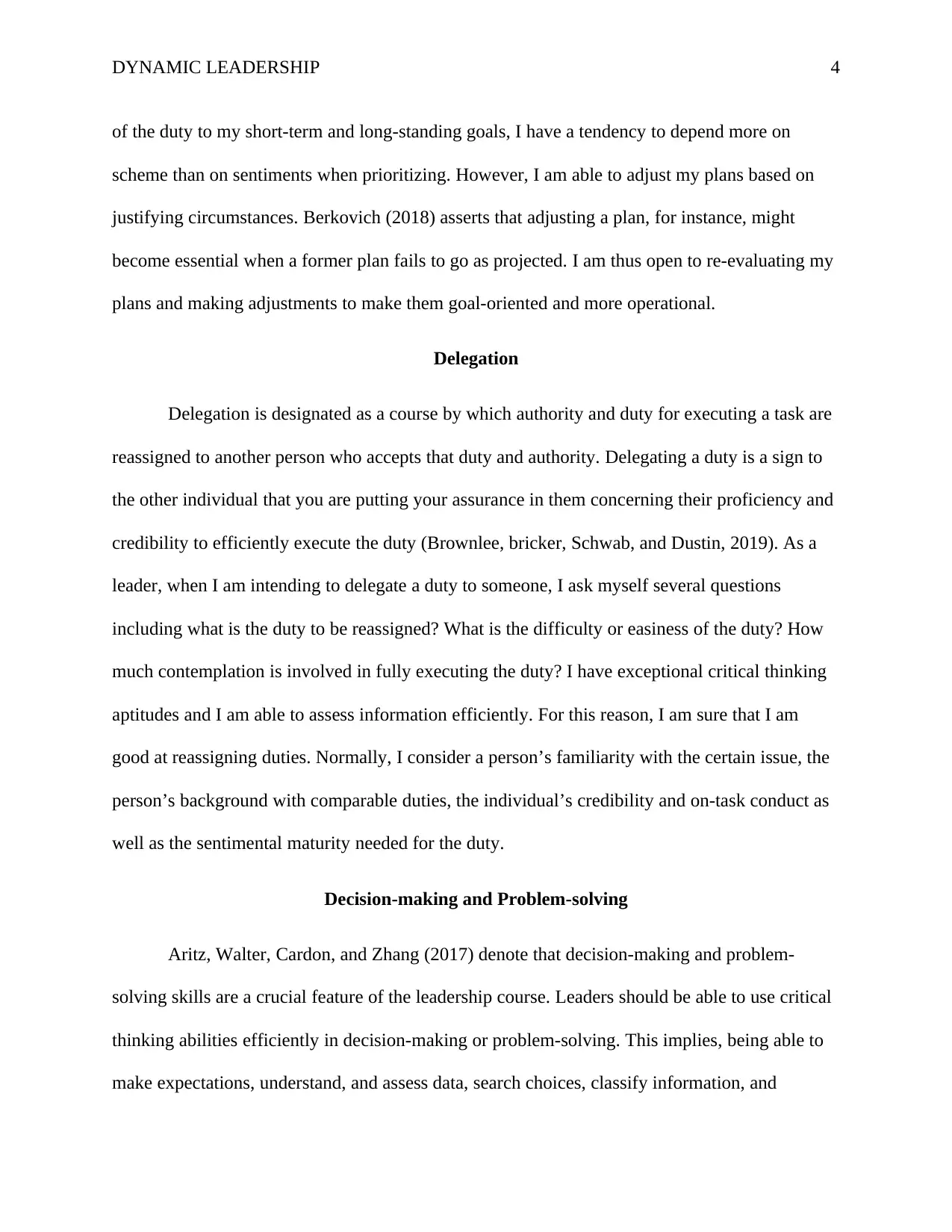
DYNAMIC LEADERSHIP 4
of the duty to my short-term and long-standing goals, I have a tendency to depend more on
scheme than on sentiments when prioritizing. However, I am able to adjust my plans based on
justifying circumstances. Berkovich (2018) asserts that adjusting a plan, for instance, might
become essential when a former plan fails to go as projected. I am thus open to re-evaluating my
plans and making adjustments to make them goal-oriented and more operational.
Delegation
Delegation is designated as a course by which authority and duty for executing a task are
reassigned to another person who accepts that duty and authority. Delegating a duty is a sign to
the other individual that you are putting your assurance in them concerning their proficiency and
credibility to efficiently execute the duty (Brownlee, bricker, Schwab, and Dustin, 2019). As a
leader, when I am intending to delegate a duty to someone, I ask myself several questions
including what is the duty to be reassigned? What is the difficulty or easiness of the duty? How
much contemplation is involved in fully executing the duty? I have exceptional critical thinking
aptitudes and I am able to assess information efficiently. For this reason, I am sure that I am
good at reassigning duties. Normally, I consider a person’s familiarity with the certain issue, the
person’s background with comparable duties, the individual’s credibility and on-task conduct as
well as the sentimental maturity needed for the duty.
Decision-making and Problem-solving
Aritz, Walter, Cardon, and Zhang (2017) denote that decision-making and problem-
solving skills are a crucial feature of the leadership course. Leaders should be able to use critical
thinking abilities efficiently in decision-making or problem-solving. This implies, being able to
make expectations, understand, and assess data, search choices, classify information, and
of the duty to my short-term and long-standing goals, I have a tendency to depend more on
scheme than on sentiments when prioritizing. However, I am able to adjust my plans based on
justifying circumstances. Berkovich (2018) asserts that adjusting a plan, for instance, might
become essential when a former plan fails to go as projected. I am thus open to re-evaluating my
plans and making adjustments to make them goal-oriented and more operational.
Delegation
Delegation is designated as a course by which authority and duty for executing a task are
reassigned to another person who accepts that duty and authority. Delegating a duty is a sign to
the other individual that you are putting your assurance in them concerning their proficiency and
credibility to efficiently execute the duty (Brownlee, bricker, Schwab, and Dustin, 2019). As a
leader, when I am intending to delegate a duty to someone, I ask myself several questions
including what is the duty to be reassigned? What is the difficulty or easiness of the duty? How
much contemplation is involved in fully executing the duty? I have exceptional critical thinking
aptitudes and I am able to assess information efficiently. For this reason, I am sure that I am
good at reassigning duties. Normally, I consider a person’s familiarity with the certain issue, the
person’s background with comparable duties, the individual’s credibility and on-task conduct as
well as the sentimental maturity needed for the duty.
Decision-making and Problem-solving
Aritz, Walter, Cardon, and Zhang (2017) denote that decision-making and problem-
solving skills are a crucial feature of the leadership course. Leaders should be able to use critical
thinking abilities efficiently in decision-making or problem-solving. This implies, being able to
make expectations, understand, and assess data, search choices, classify information, and
Paraphrase This Document
Need a fresh take? Get an instant paraphrase of this document with our AI Paraphraser

DYNAMIC LEADERSHIP 5
appraise and question outcomes for every solution. As a leader, when I experience a problem, I
tend to make decisions founded on my instinct and experience. For instance, if I had a patient
who was restless and my care plan fails to meet their needs, I would be drawn to solve the
problem by seeking help from a colleague. In other circumstances, I would likewise depend on
former experiences and try other ways I have used with similar patients. In one occurrence, I had
a patient who had a pressure ulcer and had complaints regarding her sideways lying position.
Nonetheless, I could not let her lay on her backside since it would worsen her condition. In an
attempt to solve this issue, I used other means like distracting her through the TV, engaging in a
conversation, and reading her a story to lessen and not concentrate on the uneasiness. In other
cases, I engage in trial-and-error for patients whom the usual care could be inadequate in
attaining the projected outcomes. However, I similarly apply an organized mode to solve
problems that do not need urgent action in my leadership. For instance, if I am having issues
with a colleague, I would outline the problem, pinpoint the root cause of the problem, and then
select various solutions that would best solve the problem. For every solution, I would likewise
evaluate the options, the pros, and cons of every solution and their temporary and permanent
consequences. I always ensure that I make rational decisions for the good of the organization that
has employed me.
Communication
To enable teamwork as a leader, it is essential to possess an operational communication
scheme that delivers complete and correct interchange of information that guides resolution
(Journal of Social Issues, 2018). To be pro-active, the leader has to use simple language when
relating with colleagues and knowing how to listen to the minors including personnel and
patients. As a nurse leader, I consider myself to be objectively proficient in the capacity of
appraise and question outcomes for every solution. As a leader, when I experience a problem, I
tend to make decisions founded on my instinct and experience. For instance, if I had a patient
who was restless and my care plan fails to meet their needs, I would be drawn to solve the
problem by seeking help from a colleague. In other circumstances, I would likewise depend on
former experiences and try other ways I have used with similar patients. In one occurrence, I had
a patient who had a pressure ulcer and had complaints regarding her sideways lying position.
Nonetheless, I could not let her lay on her backside since it would worsen her condition. In an
attempt to solve this issue, I used other means like distracting her through the TV, engaging in a
conversation, and reading her a story to lessen and not concentrate on the uneasiness. In other
cases, I engage in trial-and-error for patients whom the usual care could be inadequate in
attaining the projected outcomes. However, I similarly apply an organized mode to solve
problems that do not need urgent action in my leadership. For instance, if I am having issues
with a colleague, I would outline the problem, pinpoint the root cause of the problem, and then
select various solutions that would best solve the problem. For every solution, I would likewise
evaluate the options, the pros, and cons of every solution and their temporary and permanent
consequences. I always ensure that I make rational decisions for the good of the organization that
has employed me.
Communication
To enable teamwork as a leader, it is essential to possess an operational communication
scheme that delivers complete and correct interchange of information that guides resolution
(Journal of Social Issues, 2018). To be pro-active, the leader has to use simple language when
relating with colleagues and knowing how to listen to the minors including personnel and
patients. As a nurse leader, I consider myself to be objectively proficient in the capacity of
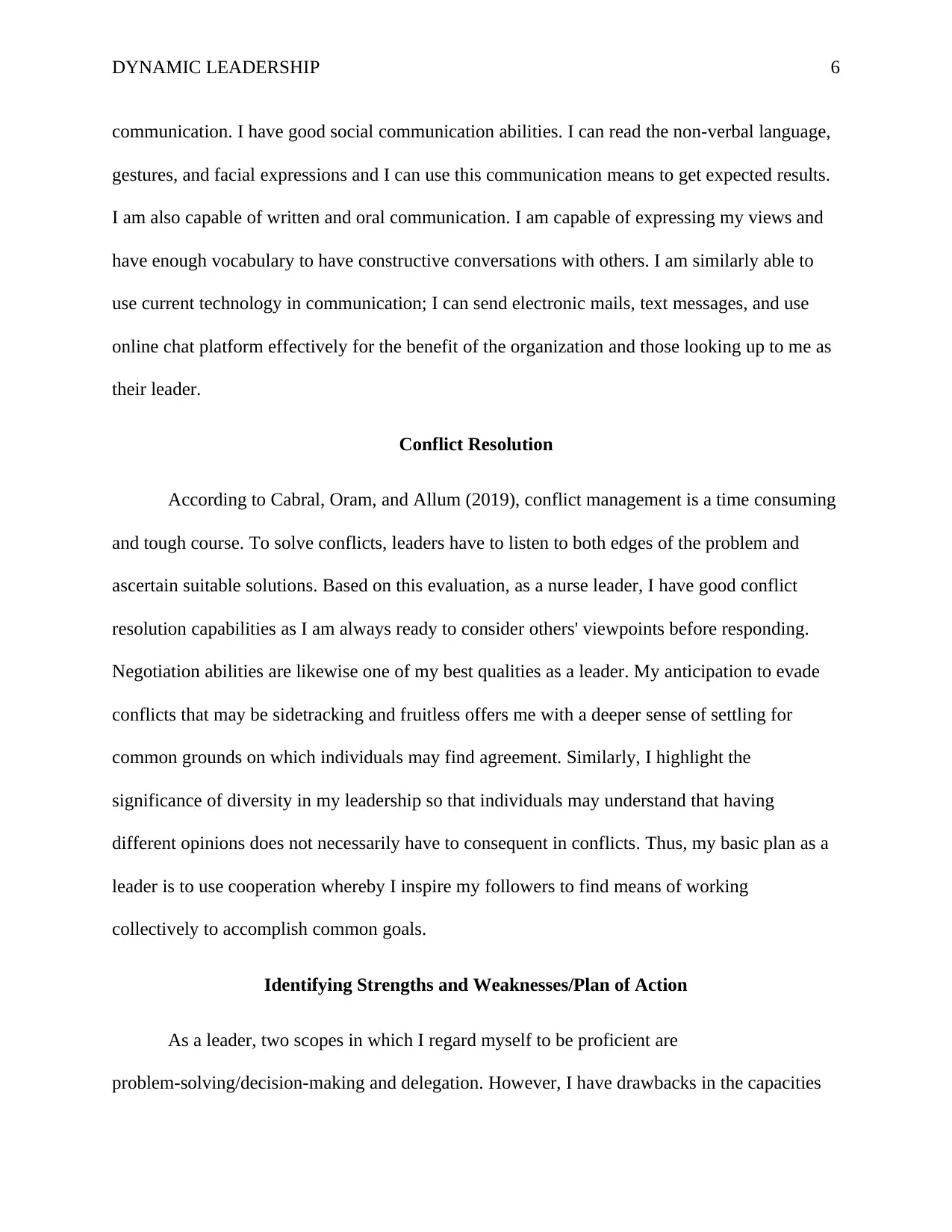
DYNAMIC LEADERSHIP 6
communication. I have good social communication abilities. I can read the non-verbal language,
gestures, and facial expressions and I can use this communication means to get expected results.
I am also capable of written and oral communication. I am capable of expressing my views and
have enough vocabulary to have constructive conversations with others. I am similarly able to
use current technology in communication; I can send electronic mails, text messages, and use
online chat platform effectively for the benefit of the organization and those looking up to me as
their leader.
Conflict Resolution
According to Cabral, Oram, and Allum (2019), conflict management is a time consuming
and tough course. To solve conflicts, leaders have to listen to both edges of the problem and
ascertain suitable solutions. Based on this evaluation, as a nurse leader, I have good conflict
resolution capabilities as I am always ready to consider others' viewpoints before responding.
Negotiation abilities are likewise one of my best qualities as a leader. My anticipation to evade
conflicts that may be sidetracking and fruitless offers me with a deeper sense of settling for
common grounds on which individuals may find agreement. Similarly, I highlight the
significance of diversity in my leadership so that individuals may understand that having
different opinions does not necessarily have to consequent in conflicts. Thus, my basic plan as a
leader is to use cooperation whereby I inspire my followers to find means of working
collectively to accomplish common goals.
Identifying Strengths and Weaknesses/Plan of Action
As a leader, two scopes in which I regard myself to be proficient are
problem-solving/decision-making and delegation. However, I have drawbacks in the capacities
communication. I have good social communication abilities. I can read the non-verbal language,
gestures, and facial expressions and I can use this communication means to get expected results.
I am also capable of written and oral communication. I am capable of expressing my views and
have enough vocabulary to have constructive conversations with others. I am similarly able to
use current technology in communication; I can send electronic mails, text messages, and use
online chat platform effectively for the benefit of the organization and those looking up to me as
their leader.
Conflict Resolution
According to Cabral, Oram, and Allum (2019), conflict management is a time consuming
and tough course. To solve conflicts, leaders have to listen to both edges of the problem and
ascertain suitable solutions. Based on this evaluation, as a nurse leader, I have good conflict
resolution capabilities as I am always ready to consider others' viewpoints before responding.
Negotiation abilities are likewise one of my best qualities as a leader. My anticipation to evade
conflicts that may be sidetracking and fruitless offers me with a deeper sense of settling for
common grounds on which individuals may find agreement. Similarly, I highlight the
significance of diversity in my leadership so that individuals may understand that having
different opinions does not necessarily have to consequent in conflicts. Thus, my basic plan as a
leader is to use cooperation whereby I inspire my followers to find means of working
collectively to accomplish common goals.
Identifying Strengths and Weaknesses/Plan of Action
As a leader, two scopes in which I regard myself to be proficient are
problem-solving/decision-making and delegation. However, I have drawbacks in the capacities
⊘ This is a preview!⊘
Do you want full access?
Subscribe today to unlock all pages.

Trusted by 1+ million students worldwide
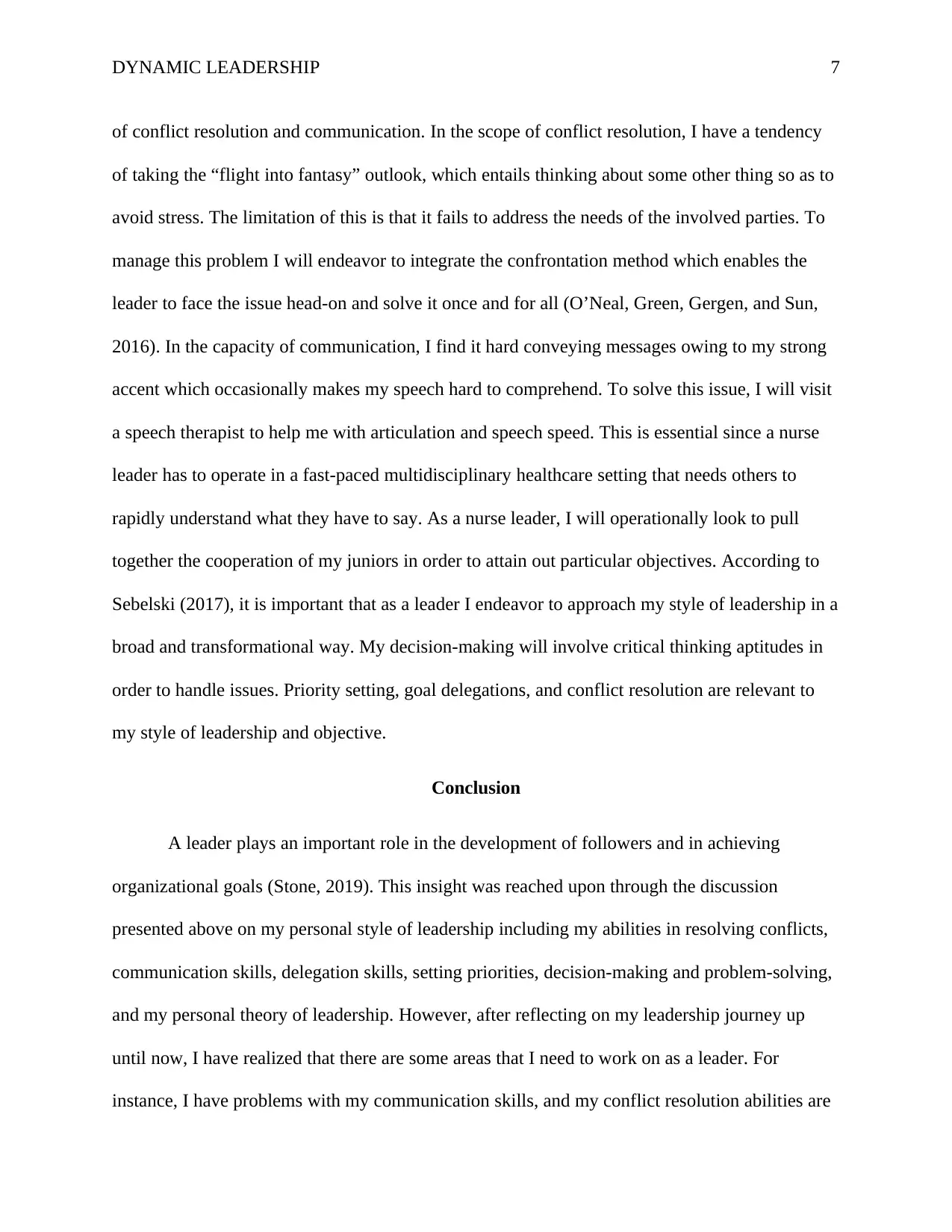
DYNAMIC LEADERSHIP 7
of conflict resolution and communication. In the scope of conflict resolution, I have a tendency
of taking the “flight into fantasy” outlook, which entails thinking about some other thing so as to
avoid stress. The limitation of this is that it fails to address the needs of the involved parties. To
manage this problem I will endeavor to integrate the confrontation method which enables the
leader to face the issue head-on and solve it once and for all (O’Neal, Green, Gergen, and Sun,
2016). In the capacity of communication, I find it hard conveying messages owing to my strong
accent which occasionally makes my speech hard to comprehend. To solve this issue, I will visit
a speech therapist to help me with articulation and speech speed. This is essential since a nurse
leader has to operate in a fast-paced multidisciplinary healthcare setting that needs others to
rapidly understand what they have to say. As a nurse leader, I will operationally look to pull
together the cooperation of my juniors in order to attain out particular objectives. According to
Sebelski (2017), it is important that as a leader I endeavor to approach my style of leadership in a
broad and transformational way. My decision-making will involve critical thinking aptitudes in
order to handle issues. Priority setting, goal delegations, and conflict resolution are relevant to
my style of leadership and objective.
Conclusion
A leader plays an important role in the development of followers and in achieving
organizational goals (Stone, 2019). This insight was reached upon through the discussion
presented above on my personal style of leadership including my abilities in resolving conflicts,
communication skills, delegation skills, setting priorities, decision-making and problem-solving,
and my personal theory of leadership. However, after reflecting on my leadership journey up
until now, I have realized that there are some areas that I need to work on as a leader. For
instance, I have problems with my communication skills, and my conflict resolution abilities are
of conflict resolution and communication. In the scope of conflict resolution, I have a tendency
of taking the “flight into fantasy” outlook, which entails thinking about some other thing so as to
avoid stress. The limitation of this is that it fails to address the needs of the involved parties. To
manage this problem I will endeavor to integrate the confrontation method which enables the
leader to face the issue head-on and solve it once and for all (O’Neal, Green, Gergen, and Sun,
2016). In the capacity of communication, I find it hard conveying messages owing to my strong
accent which occasionally makes my speech hard to comprehend. To solve this issue, I will visit
a speech therapist to help me with articulation and speech speed. This is essential since a nurse
leader has to operate in a fast-paced multidisciplinary healthcare setting that needs others to
rapidly understand what they have to say. As a nurse leader, I will operationally look to pull
together the cooperation of my juniors in order to attain out particular objectives. According to
Sebelski (2017), it is important that as a leader I endeavor to approach my style of leadership in a
broad and transformational way. My decision-making will involve critical thinking aptitudes in
order to handle issues. Priority setting, goal delegations, and conflict resolution are relevant to
my style of leadership and objective.
Conclusion
A leader plays an important role in the development of followers and in achieving
organizational goals (Stone, 2019). This insight was reached upon through the discussion
presented above on my personal style of leadership including my abilities in resolving conflicts,
communication skills, delegation skills, setting priorities, decision-making and problem-solving,
and my personal theory of leadership. However, after reflecting on my leadership journey up
until now, I have realized that there are some areas that I need to work on as a leader. For
instance, I have problems with my communication skills, and my conflict resolution abilities are
Paraphrase This Document
Need a fresh take? Get an instant paraphrase of this document with our AI Paraphraser

DYNAMIC LEADERSHIP 8
not the best. Self-leadership through individual training and reflection provides a basis for
operational leadership skills. Hougaard, Carter, and Afton (2018) allude that as part of leading
self, operational leaders have to demonstrate self-awareness, self-managing, self-development,
and demonstrating personality.
not the best. Self-leadership through individual training and reflection provides a basis for
operational leadership skills. Hougaard, Carter, and Afton (2018) allude that as part of leading
self, operational leaders have to demonstrate self-awareness, self-managing, self-development,
and demonstrating personality.

DYNAMIC LEADERSHIP 9
References
Aritz, J., Walker, R., Cardon, P., & Zhang Li. (2017). Discourse of Leadership: The Power of
Questions in Organizational Decision Making. International Journal of Business
Communication, 54(2), 161–181. https://doi.org/10.1177/2329488416687054
Berkovich, I. (2018). Will it sink or will it float. Educational Management Administration &
Leadership, 46(6), 888–907. https://doi.org/10.1177/1741143217714253
Brownlee, M. T. J., Bricker, K., Schwab, K., & Dustin, D. (2019). Seven Characteristics of
Highly Effective Leaders. Journal of Park & Recreation Administration, 37(1), 154–157.
Retrieved from http://search.ebscohost.com/login.aspx?
direct=true&db=s3h&AN=135550797&site=ehost-live
Cabral, A., Oram, C., & Allum, S. (2019). Developing nursing leadership talent—Views from
the NHS nursing leadership for south‐east England. Journal of Nursing
Management, 27(1), 75–83. https://doi.org/10.1111/jonm.12650
Drescher, G. (2017). Delegation outcomes: perceptions of leaders and follower’s
satisfaction. Journal of Managerial Psychology, 32(1), 2–15.
https://doi.org/10.1108/JMP-05-2015-0174
Germain, J. (2017). Reflections on Leadership: Theory, Experience, and Practice. Quest
(00336297), 69(2), 169–176. Retrieved from http://search.ebscohost.com/login.aspx?
direct=true&db=s3h&AN=123150245&site=ehost-live
Hougaard, R., Carter, J., & Afton, M. (2018). Self-Awareness Can Help Leaders More Than an
MBA Can. Harvard Business Review Digital Articles, 2–5. Retrieved from
References
Aritz, J., Walker, R., Cardon, P., & Zhang Li. (2017). Discourse of Leadership: The Power of
Questions in Organizational Decision Making. International Journal of Business
Communication, 54(2), 161–181. https://doi.org/10.1177/2329488416687054
Berkovich, I. (2018). Will it sink or will it float. Educational Management Administration &
Leadership, 46(6), 888–907. https://doi.org/10.1177/1741143217714253
Brownlee, M. T. J., Bricker, K., Schwab, K., & Dustin, D. (2019). Seven Characteristics of
Highly Effective Leaders. Journal of Park & Recreation Administration, 37(1), 154–157.
Retrieved from http://search.ebscohost.com/login.aspx?
direct=true&db=s3h&AN=135550797&site=ehost-live
Cabral, A., Oram, C., & Allum, S. (2019). Developing nursing leadership talent—Views from
the NHS nursing leadership for south‐east England. Journal of Nursing
Management, 27(1), 75–83. https://doi.org/10.1111/jonm.12650
Drescher, G. (2017). Delegation outcomes: perceptions of leaders and follower’s
satisfaction. Journal of Managerial Psychology, 32(1), 2–15.
https://doi.org/10.1108/JMP-05-2015-0174
Germain, J. (2017). Reflections on Leadership: Theory, Experience, and Practice. Quest
(00336297), 69(2), 169–176. Retrieved from http://search.ebscohost.com/login.aspx?
direct=true&db=s3h&AN=123150245&site=ehost-live
Hougaard, R., Carter, J., & Afton, M. (2018). Self-Awareness Can Help Leaders More Than an
MBA Can. Harvard Business Review Digital Articles, 2–5. Retrieved from
⊘ This is a preview!⊘
Do you want full access?
Subscribe today to unlock all pages.

Trusted by 1+ million students worldwide
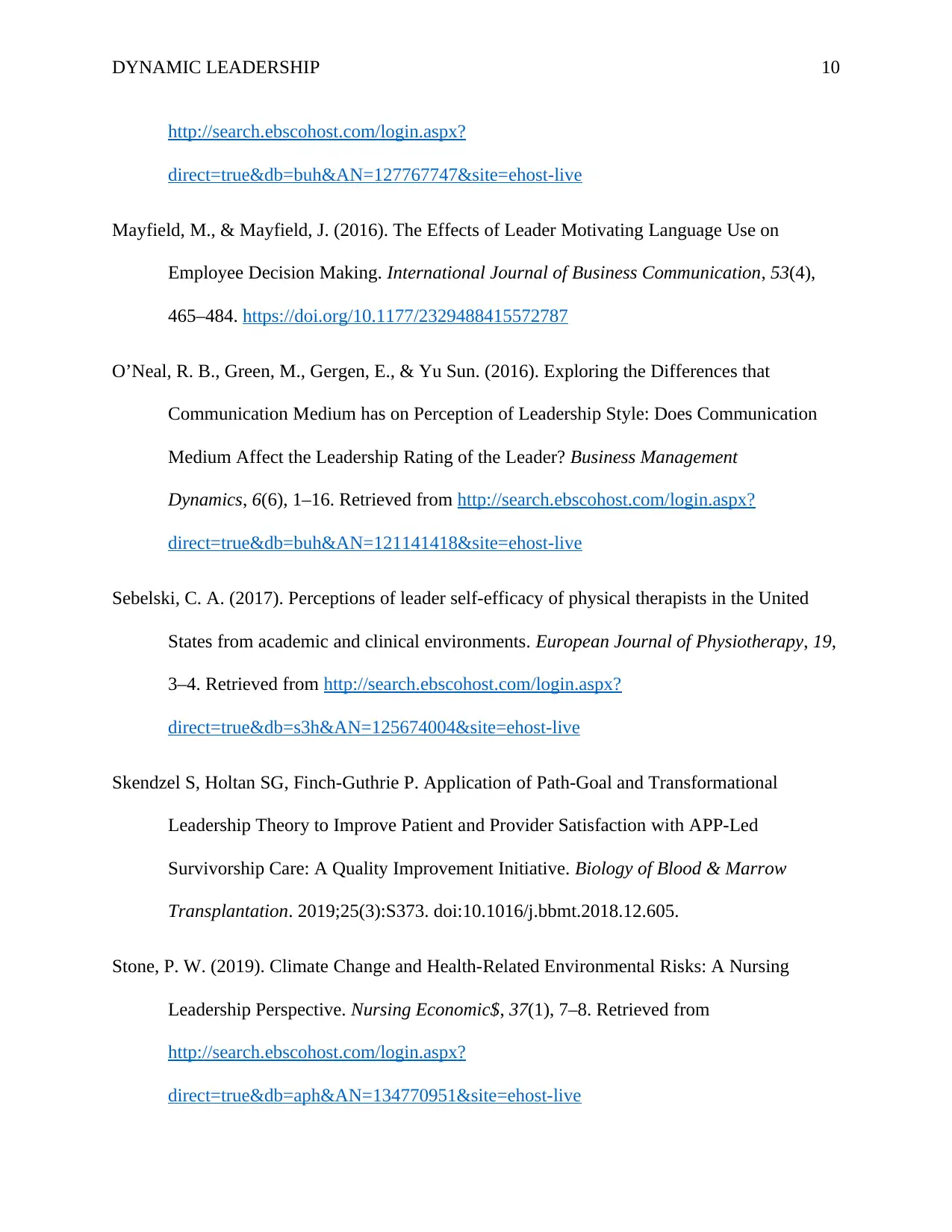
DYNAMIC LEADERSHIP 10
http://search.ebscohost.com/login.aspx?
direct=true&db=buh&AN=127767747&site=ehost-live
Mayfield, M., & Mayfield, J. (2016). The Effects of Leader Motivating Language Use on
Employee Decision Making. International Journal of Business Communication, 53(4),
465–484. https://doi.org/10.1177/2329488415572787
O’Neal, R. B., Green, M., Gergen, E., & Yu Sun. (2016). Exploring the Differences that
Communication Medium has on Perception of Leadership Style: Does Communication
Medium Affect the Leadership Rating of the Leader? Business Management
Dynamics, 6(6), 1–16. Retrieved from http://search.ebscohost.com/login.aspx?
direct=true&db=buh&AN=121141418&site=ehost-live
Sebelski, C. A. (2017). Perceptions of leader self-efficacy of physical therapists in the United
States from academic and clinical environments. European Journal of Physiotherapy, 19,
3–4. Retrieved from http://search.ebscohost.com/login.aspx?
direct=true&db=s3h&AN=125674004&site=ehost-live
Skendzel S, Holtan SG, Finch-Guthrie P. Application of Path-Goal and Transformational
Leadership Theory to Improve Patient and Provider Satisfaction with APP-Led
Survivorship Care: A Quality Improvement Initiative. Biology of Blood & Marrow
Transplantation. 2019;25(3):S373. doi:10.1016/j.bbmt.2018.12.605.
Stone, P. W. (2019). Climate Change and Health-Related Environmental Risks: A Nursing
Leadership Perspective. Nursing Economic$, 37(1), 7–8. Retrieved from
http://search.ebscohost.com/login.aspx?
direct=true&db=aph&AN=134770951&site=ehost-live
http://search.ebscohost.com/login.aspx?
direct=true&db=buh&AN=127767747&site=ehost-live
Mayfield, M., & Mayfield, J. (2016). The Effects of Leader Motivating Language Use on
Employee Decision Making. International Journal of Business Communication, 53(4),
465–484. https://doi.org/10.1177/2329488415572787
O’Neal, R. B., Green, M., Gergen, E., & Yu Sun. (2016). Exploring the Differences that
Communication Medium has on Perception of Leadership Style: Does Communication
Medium Affect the Leadership Rating of the Leader? Business Management
Dynamics, 6(6), 1–16. Retrieved from http://search.ebscohost.com/login.aspx?
direct=true&db=buh&AN=121141418&site=ehost-live
Sebelski, C. A. (2017). Perceptions of leader self-efficacy of physical therapists in the United
States from academic and clinical environments. European Journal of Physiotherapy, 19,
3–4. Retrieved from http://search.ebscohost.com/login.aspx?
direct=true&db=s3h&AN=125674004&site=ehost-live
Skendzel S, Holtan SG, Finch-Guthrie P. Application of Path-Goal and Transformational
Leadership Theory to Improve Patient and Provider Satisfaction with APP-Led
Survivorship Care: A Quality Improvement Initiative. Biology of Blood & Marrow
Transplantation. 2019;25(3):S373. doi:10.1016/j.bbmt.2018.12.605.
Stone, P. W. (2019). Climate Change and Health-Related Environmental Risks: A Nursing
Leadership Perspective. Nursing Economic$, 37(1), 7–8. Retrieved from
http://search.ebscohost.com/login.aspx?
direct=true&db=aph&AN=134770951&site=ehost-live
Paraphrase This Document
Need a fresh take? Get an instant paraphrase of this document with our AI Paraphraser
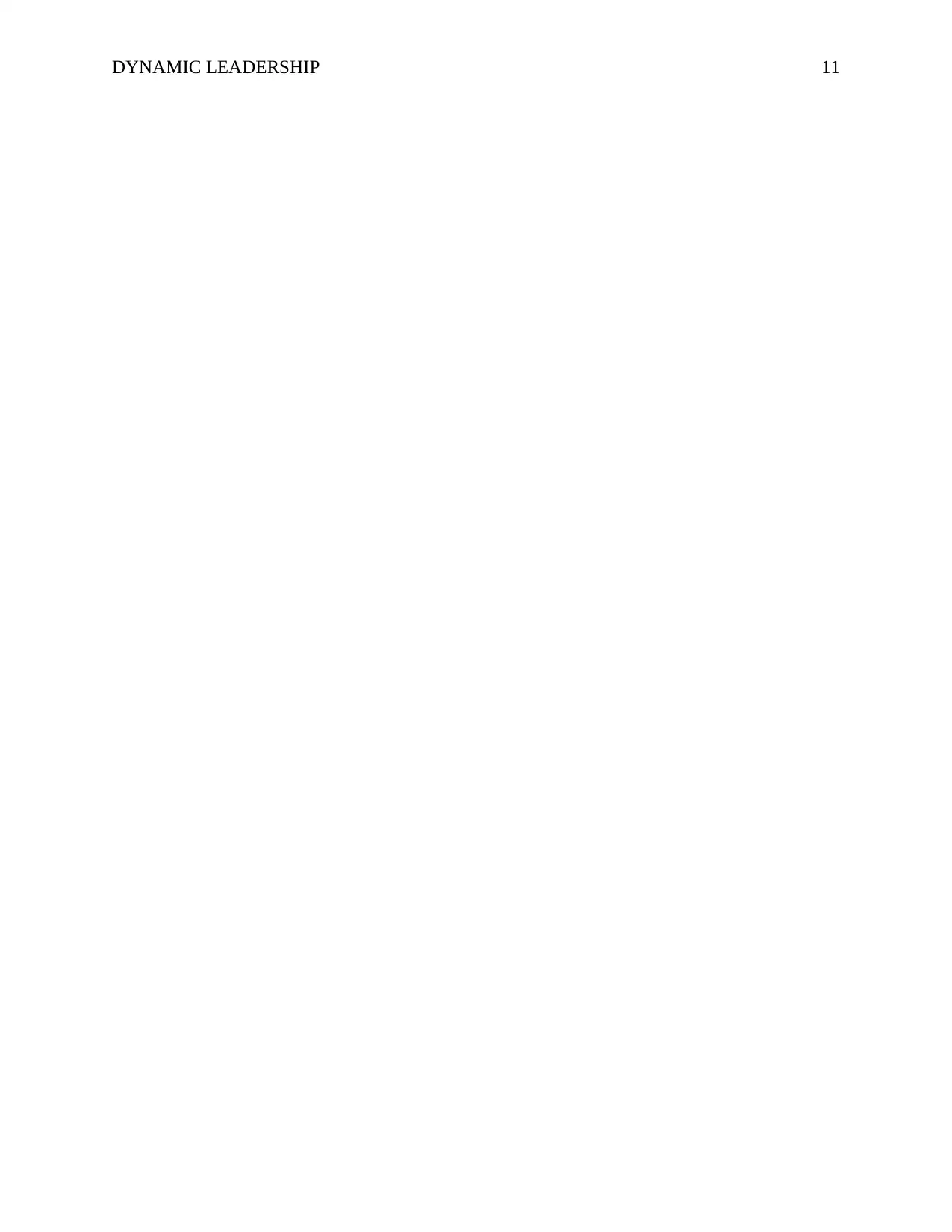
DYNAMIC LEADERSHIP 11
1 out of 11
Related Documents
Your All-in-One AI-Powered Toolkit for Academic Success.
+13062052269
info@desklib.com
Available 24*7 on WhatsApp / Email
![[object Object]](/_next/static/media/star-bottom.7253800d.svg)
Unlock your academic potential
Copyright © 2020–2025 A2Z Services. All Rights Reserved. Developed and managed by ZUCOL.





